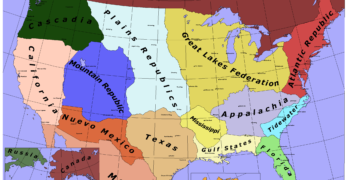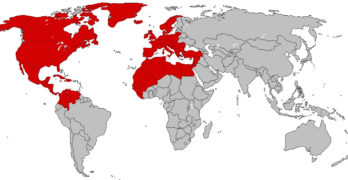
Human population growth rate in percent, with the variables of births, deaths, immigration, and emigration – 2013
Eric Teetsel and Andrew T. Walker
The overpopulation crisis predicted by Malthusians has failed to materialize. Instead, developed nations face serious underpopulation. To solve this problem, we must rediscover the importance of children.
In a recent mini-documentary, the New York Times investigates the unrealized horrors of population explosion, especially those predicted by Paul Ehrlich in his 1968 book, The Population Bomb. Despite the failure of his forecast, Ehrlich remains undaunted. “The end is still nigh,” he says according to the Times, and population control ought to be implemented, “preferably through voluntary methods.” But, Ehrlich continues, allowing women to choose to have as many children as they desire is like allowing everyone to “throw as much of their garbage into their neighbor’s backyard as they want.”
In our view, Ehrlich fundamentally misunderstands the value of human life, the actual population threat facing the earth, and what can be done to stop it.
Scrooge, Malthus, and Ehrlich
In the first chapter of Dickens’s classic A Christmas Carol, we are introduced to the unforgettable Ebenezer Scrooge, a dismal miser who loathes Christmas. In one of a series of interactions proving his bitterness, Scrooge is solicited for a charitable donation:
A few of us are endeavoring to raise a fund to buy the Poor some meat and drink, and means of warmth. We choose this time, because it is a time, of all others, when Want is keenly felt, and Abundance rejoices. What shall I put you down for?
“Nothing!’” Scrooge replied.
“You wish to be anonymous?’”
“I wish to be left alone,” said Scrooge. “Since you ask me what I wish, gentlemen, that is my answer. I don’t make merry myself at Christmas and I can’t afford to make idle people merry. I help to support the establishments I have mentioned: they cost enough: and those who are badly off must go there.”
“Many can’t go there; and many would rather die.”
“If they would rather die,” said Scrooge, “they had better do it, and decrease the surplus population.”
With one cold economic term, Scrooge evaluates the worth of an entire class of humanity: “the surplus population.” When writing these lines it is likely Dickens had in mind the scholarship of Thomas Robert Malthus, whose Essay on the Principle of Population (1798) remains among the most influential books on the supposed problem of population growth.
Malthus predicted catastrophe because the population was growing faster than the food supply. Though Malthus himself was reasonably humane about what could and should be done about this, his book inspired generations of neo-Malthusians to view humanity as a scourge and to advocate creative solutions to the problem of our existence.
Paul Ehrlich is simply a contemporary example of this school of thought. His 1968 book sold millions and caused a national sensation, thanks to its alarmist tone. The first page poses the question: “Population control—or race to oblivion?” Faced with that choice, Ehrlich matter-of-factly prescribes a number of Scrooge-like solutions to the problem of surplus population:
Will we be willing to slaughter our dogs and cats in order to divert pet food protein to the starving masses in Asia? . . .
Many of my colleagues feel that some sort of compulsory birth regulation would be necessary to achieve such control. One plan often mentioned involves the addition of temporary sterilants to water supplies or staple food. Doses of the antidote would be carefully rationed by the government to produce the desired population size. . . .
Another possibility might be to reverse the government’s present system of encouraging reproduction and replace it with a series of financial rewards and penalties designed to discourage reproduction . . . In short, the plush life would be difficult to attain for those with large families—which is as it should be, since they are getting their pleasure from their children, who are being supported in part by more responsible members of society.
Ehrlich is just getting warmed up. He writes,
Obviously, such measures should be coordinated by a powerful government agency. A federal Bureau of Population and Environment should be set up to determine the optimum population size for the United States and devise measures to establish it.
Among his other ideas are “ample funds” to research human sex determination, government investment in new forms of contraceptives, abortion right guarantees, and sex education for children “de-emphasizing the reproductive role of sex.”
Overpopulation Meets Human Innovation
Ehrlich’s solutions to the problem of overpopulation are obviously deplorable. Ultimately, they are based on a false choice between these policies and mass starvation leading to eventual extinction. Given those options, his solutions might seem understandable.
But here’s the thing about trend lines: they’re only true until they aren’t anymore. History is full of game-changing achievements in science, engineering, and technology. The mistake of the Malthusians is to underestimate the human capacity for innovation.
Take the problem of food production, for example. This was an area of intense concern for scientists and politicians in the early twentieth century, especially in densely populated poor nations such as Mexico and India.
An American scientist named Norman Borlaug dedicated his life to the problem, and in the 1950s developed a strain of wheat capable of producing a much higher yield than previously possible. Over the next two decades, Borlaug introduced varieties of his wheat suited to the climate and conditions of nations around the world. He is credited with saving a billion lives from starvation. While Paul Ehrlich was on tour promoting The Population Bomb, Norman Borlaug was accepting the Nobel Peace Prize.
The fear-mongering population controllers have been proven wrong. Since 1970, the world population has doubled to over 7 billion. Though starvation is a problem in many places, it is a man-made one resulting from government corruption, mismanagement, and war. So long as societies inculcate the entrepreneurial mindset, we can expect innovations in natural gas, electric cars, and renewable technologies to overcome the diminishing supplies of oil, too, and whatever fear may come after that.
The Real Population Problem
Yet there is one issue of critical importance that should concern us, one for which there does not appear to be a viable or acceptable technological solution. It is a population problem, but the opposite of the one feared: the world is running out of people.
In the 1980s, the Communist party in China implemented a series of Malthusian measures to restrict the size of the country’s population, including the infamous “one-child policy” that resulted in forced abortions and involuntary sterilizations. It worked, and now China is faced with the consequences of an aging population it can’t replace. Because of the importance Chinese culture places on having a male heir, there are now forty million more young men than women.
In his remarkable book, What to Expect When No One’s Expecting, Jonathan Last compares the effect of China’s one-child policy to the birthrate among middle-class Americans: “As a result of One-Child, the fertility rate in China is roughly 1.54. In America, the fertility rate for white, college-educated women . . . is 1.6.” Last continues, “In other words, America has created its very own One-Child Policy. It’s soft and unintentional, the result of accidents of history and thousands of little choices. But it has been just as effective.”
When discussing sociological metrics such as the fertility rate, it is easy to become lost in the weeds. To keep it simple, remember that in order simply to maintain its population, a nation needs a total fertility rate (TFR) of 2.1.
According to data from the CIA, few industrialized nations surpassed the 2.1 threshold of sustainability in 2014: Israel (2.62) and Mexico (2.29) were among the exceptions. Almost all others fell below the line, including Ireland (2.0), Australia (1.8), Canada (1.6), China (1.54), Spain (1.5), Germany (1.4), Poland (1.3), and South Korea (1.2).
What happens when we extrapolate these numbers into the future? Assuming the TFRs of Japan and Italy remain steady at 1.56 and 1.3 until the year 2100, their populations will plummet. This chart lays out their current and projected populations:
 Based on these data, in January 2014 The Economist described the potential calamity facing “the vanishing Japanese.” Among the areas affected are state and corporate welfare and pension systems in which current workers pay for retirees. Without a sufficient base of workers contributing to these systems, the math doesn’t work. Housing prices, wages, and debt are some of the other macroeconomic issues countries like Japan (which is to say, almost every industrialized nation) are likely to face.
Based on these data, in January 2014 The Economist described the potential calamity facing “the vanishing Japanese.” Among the areas affected are state and corporate welfare and pension systems in which current workers pay for retirees. Without a sufficient base of workers contributing to these systems, the math doesn’t work. Housing prices, wages, and debt are some of the other macroeconomic issues countries like Japan (which is to say, almost every industrialized nation) are likely to face.
Although the numbers in the chart above look bleak, expecting the current TFR to remain constant is actually generous. Historically, as nations have become wealthier and better educated, their TFRs have declined. Consider the history of the TFR in the United States, broken down by race:
 Notice that the TFR among black Americans is historically higher than that of white Americans, but also that the trends are remarkably similar for each group. As the Industrial Revolution took hold and Americans became wealthier, the TFR declined. The famous “Baby Boom” following World War II affected both groups, but soon gave way to a gradual decline.
Notice that the TFR among black Americans is historically higher than that of white Americans, but also that the trends are remarkably similar for each group. As the Industrial Revolution took hold and Americans became wealthier, the TFR declined. The famous “Baby Boom” following World War II affected both groups, but soon gave way to a gradual decline.
It would be a mistake to look at these data and the long-term catastrophic effects of population decline and begin to develop our own Malthusian solutions. The fact that increasing wealth has led to greater education and opportunities for Americans, regardless of sex or race, is a tremendous blessing for which we should be thankful. The fix for the problem of under-population is not reverting to the days of poverty and oppression in some dystopian future reminiscent of The Hunger Games.
So what is it?
The Value of Children
To solve the problem of decreasing populations, our cultures must rediscover the importance of children.
Although this sounds like a simple solution, it will not be an easy one. For years, modern societies have signaled their lack of interest in large families. Christians might pray for a great spiritual awakening. Widespread spiritual revival has occurred twice in America’s past, and might again. Such a movement might be powerful and pervasive enough to disentangle the web of factors depressing the choice to create sizable families.
The period of the “Baby Boom” was also one of religious resurgence. The 1940s and 1950s saw the rise of Billy Graham and the establishment of influential Christian organizations, including Christianity Today, Campus Crusade for Christ, Youth for Christ, and the National Association of Evangelicals. In 1939, just 37 percent of Americans said they attended church, synagogue, or mosque each week. According to Gallup, by 1959 that number had risen to 49 percent, the high-water mark in modern American history.
The most religious era of the past seventy-four years—at least based on this measure of weekly church attendance—was from the mid-to-late 1950s into the early 1960s, when, at some points, almost half of American adults said they had attended religious services in the past seven days. During this era, marked by the high fertility rates and family formation that were the foundation of the baby boomer generation, the percentage who reported that religion was important also reached high points, and almost all Americans identified with a religion.
Belief reshapes what we care about and how we live. Faith bestows a different perspective on life, often in ways that seem bizarre and imprudent to outsiders.
In a culture of consumption, it is easy to analyze the value of children in purely economic terms. And while the economic case for children is solid on the macro level, it is less so for a man and a woman sitting at the kitchen table, surrounded by bills, looking at the costs of college and the cars in their neighbors’ driveways.
The decision to have children is an act of faith. It will come with costs and sacrifice, especially fiscally and emotionally. But God’s mandate to “fill the earth” starts with those willing to believe that, just as the Lord is faithful to those who develop innovations to feed millions, he is faithful to families trying to feed their children. Not only does he provide all that we need, he shows us that not all that is good can be measured in dollars and cents.
Eric Teetsel is executive director of the Manhattan Declaration. Andrew T. Walker is the Director of Policy Studies at the Ethics & Religious Liberty Commission of the Southern Baptist Convention. This essay is adapted from their new book, Marriage Is: How Marriage Transforms Society and Cultivates Human Flourishing.
Source, Public Discourse via Watchman Research Media



















































